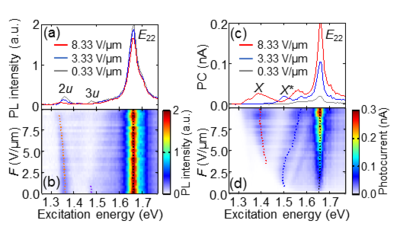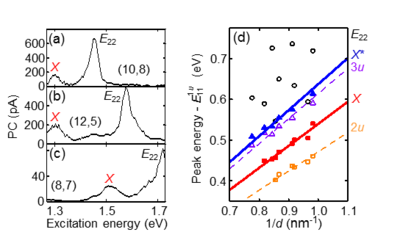Research:Electric-field induced activation of dark excitonic states in carbon nanotubes
Optical properties of carbon nanotubes are dominated by tightly bound electron-hole pair, so-called excitons, because of its one dimensionality. These excitons have a series of excited states in a manner similar to the Rydberg states in atomic hydrogen, and each state have either odd or even parity. Since optical transitions are only allowed to odd parity states, states with odd parity are called “bright” excitonic states, while states with even parity are called “dark” excitonic states. In this work, we show the emergence of optical transition to such “dark” excitonic states by electrically breaking the symmetry.

We use field effect transistors with single suspended carbon nanotube, and investigated the electric field effects on photocurrent and photoluminescence excitation spectra. When the applied filed increase, the new peaks (X, X*) appeared in the photocurrent spcetra. These peaks are at energies near the excited stats (2u, 3u) in photoluminescence excitation spectra, but at different energies.

To assign the peaks, we have performed same measurement on various nanotubes with different chirality and clarified the diameter dependence of the energy separations of X, and X* from the luminescence energies. As shown in Figure above, the energy separations are inversely proportional to the tube diameter. These results show that the peaks (X, X*) are dark excitonic states which became optically active because of applied electric-field induced symmetry breaking.
To learn more about this work, please refer to:
Electric-field induced activation of dark excitonic states in carbon nanotubes
Nano Lett.
16, 2278 (2016).
![]()